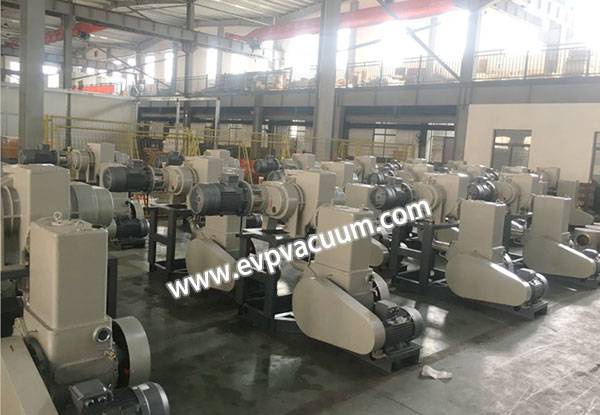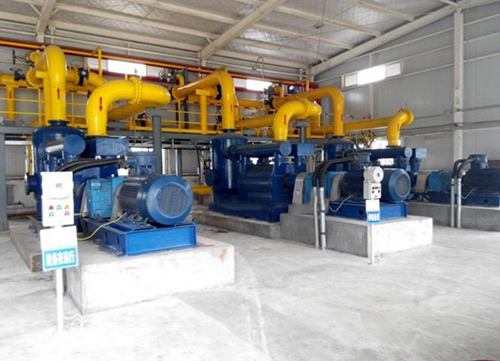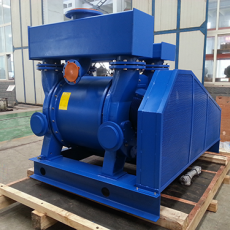Vacuum pump system for Magnesium refinery
Working principle
1. production material
1) Dolomite
The particle size of dolomite is required to be 10-40mm, and the part exceeding the upper limit of 40mm and the lower limit of 10mm shall not exceed 5%.
The chemical composition of dolomite:
MgO: 19-21%; CaO: 30-33%; SiO2<0.5%; Fe2O3<0.5%; Al2O3<0.5%; Na2O<0.005%; K2O<0.005%; Mn<0.0005%; where CaO/ MgO=1.394 (Mass ratio), CaO/MgO=1.0 (molar ratio).
2) Ferrosilicon
The ferrosilicon is selected to contain Si≥75%, that is, 75# ferrosilicon composed of 49.92% Si and 50.08% FeSi2.
3) Fluorite powder
CaF2>90% in fluorite powder has a particle size of 200 mesh.
2. Energy-saving measures adopted in the production line
The combustion equipment uses energy-saving burners to automatically control the air distribution volume to reduce the loss of incomplete fuel combustion.
The refractory bricks of the rotary kiln adopt light-weight insulation on the outer layer and composite bricks with refractory and wear-resistant inner layer to reduce heat dissipation from the outer skin of the rotary kiln.
A vertical preheater is installed at the end of the rotary kiln, which makes full use of the high-temperature flue gas generated by the combustion of the rotary kiln to preheat the materials in the preheater, so that the materials are partially decomposed in the preheater.
There is a vertical cooler at the head of the rotary kiln, which makes full use of the heat contained in the high-temperature calcined white material of the rotary kiln to preheat the secondary air to 600°C, which improves the thermal efficiency. The kiln head adopts the integrated design and construction of the vertical cooler and the kiln head cover, which occupies a small area and has good airtightness, effectively avoiding the unorganized discharge of hot exhaust gas.
The kiln tail is environmentally friendly and dust collection is good. The cyclone dust collector and pulse bag dust collector are used for secondary dust removal, and the dust removal effect is good.
The level of automation is high. The adjustment, control and alarm of the production system are controlled by PLC in the main control room. There are few on-site operators and high labor efficiency.
3.Production process
Magnesium metal smelting adopts a mature, reliable and reasonable new Pidgeon magnesium smelting process in the selection of process flow.
Qualified dolomite is sent to the rotary kiln for calcination; then the calcined dolomite, fluorite, and ferrosilicon are mixed in a certain proportion, and then ball milled and pressed into pellets; put into the reduction tank under vacuum conditions, High-temperature thermal reduction is performed to obtain crystalline magnesium; crystalline magnesium can be remelted and refined to obtain metallic magnesium. Including raw material storage, dolomite calcination, grinding and pressing, reduction and refining, etc.
Raw material reserve
Dolomite is crushed in the mine to meet the required particle size and stored in the dolomite yard in the factory. Ferrosilicon and fluorite are directly stored in the warehouse in the factory. The reserves are all considered based on the amount required for production in half a month.
Dolomite calcination workshop
Use energy-saving and environmentally-friendly rotary kiln with vertical preheater and vertical cooler. The foreign dolomite whose particle size and quality meet the requirements is unloaded to the stockyard. The loader performs stacking and reclaiming operations.
After screening by the vibrating screen, the dolomite with a particle size of 10-40mm is transported to the vertical preheater of the rotary kiln via a belt. The top silo enters the preheater through the feed pipe and exchanges heat with the high-temperature flue gas flowing in from the rotary kiln. The material is preheated to above 800℃, dropped into the transfer chute, and then enters the rotary kiln to be calcined at 1250℃ to become active calcined white. Then it is discharged into the cooler, where the high-temperature calcined white heat exchanges with the cold air blown by the fan, the active calcined white is cooled to below 100°C, and the air is preheated to above 600°C. The cooled active calcined white is discharged from the cooler and transported to the ball making workshop via the scale conveyor.
The main reactions are as follows:
CaCO3•MgCO3 = CaO•MgO + 2CO2
The high-temperature flue gas produced by the combustion of the rotary kiln exchanges heat with the dolomite in the preheater, and the temperature drops below 220℃, and then enters the bag filter. After the dust is removed, the high-temperature fan is discharged into the atmosphere, and the exhaust gas contains dust The concentration is less than the specified standard.
The whole line adopts advanced technology and reliable PLC control system, centralized operation and management in the main control room.
Ball workshop
The calcined dolomite is fed into the 1# silo by the elevator for standby; the ferrosilicon is crushed to below 20mm by the jaw crusher, and then is lifted into the 2# ferrosilicon block storage bin by the elevator for standby; the fluorite powder is lifted into the single bucket. 3# Silo. The three kinds of raw materials stored in the storage bin are continuously mixed with the ball mill controlled by the microcomputer. The particle size requirement is less than 100 mesh. The mixed powder enters the ball press after passing through the elevator, storage bin and buried scraper conveyor. Make pellets. The batching system uses an intelligent control system, and the entire process is fully automated with computer monitoring. The ball mill is driven by a 10kV high-voltage motor, which reduces power consumption compared to the original 380V low-voltage power distribution operation.
There are 3 sets of dust removal systems in the ball making workshop, respectively C1# dust removal system is installed at the ferrosilicon crushing part, C2# dust removal system is installed at the batching grinding, and C3# dust removal system is installed at the pressure ball. After comprehensive dust removal treatment, the operating environment of the ball-making workshop is greatly improved compared with the traditional workshop, and the working environment of workers is improved.
Reduction and refining workshop
The reduction furnace adopts high-temperature air rapid reversing regenerative combustion technology, and the regenerative reduction furnace uses coal gas as fuel for continuous heating. The pellets are fed into the reduction tank in the reduction furnace by the feeder. The magnesium vapor generated in the reduction tank is condensed into crystalline magnesium (crude magnesium) in the end condenser, and the crude magnesium is taken out to the refining and alloy production line.
Process flow

Suggested vacuum equipment
Roots-rotary piston vacuum system with inlet filter

Edited by: Catherine Qin; Copyright: EVP Vacuum Pump
Related products: Roots-rotary piston vacuum system
(The article comes from the Internet. If reprinting is not allowed, please contact our company to delete it.)



